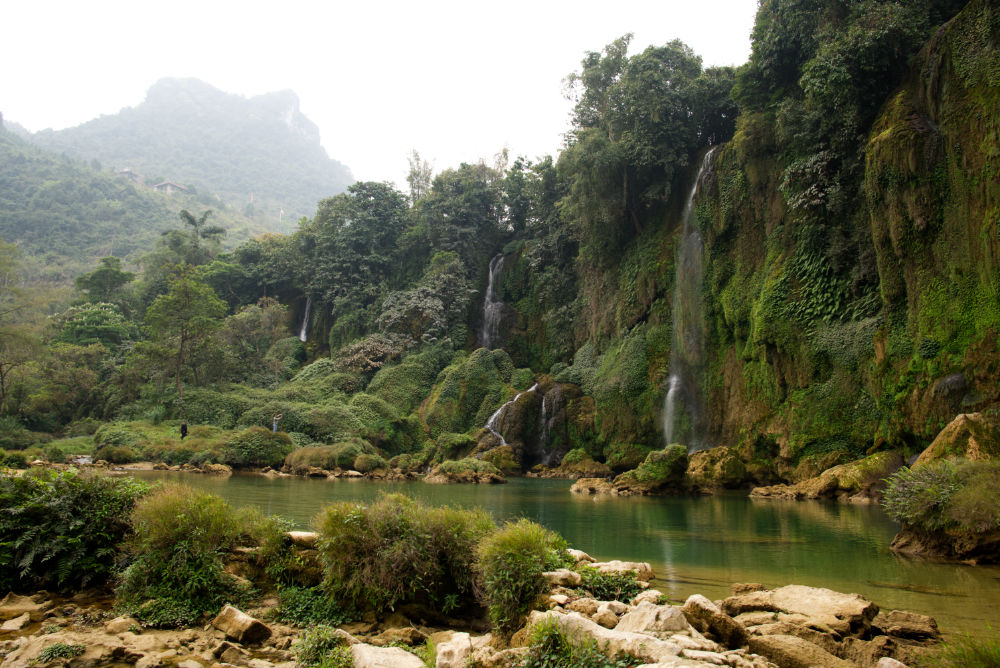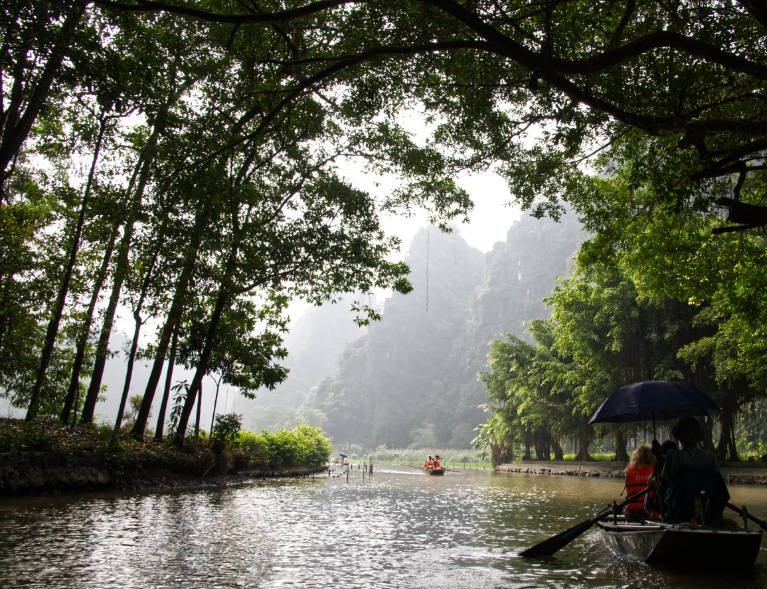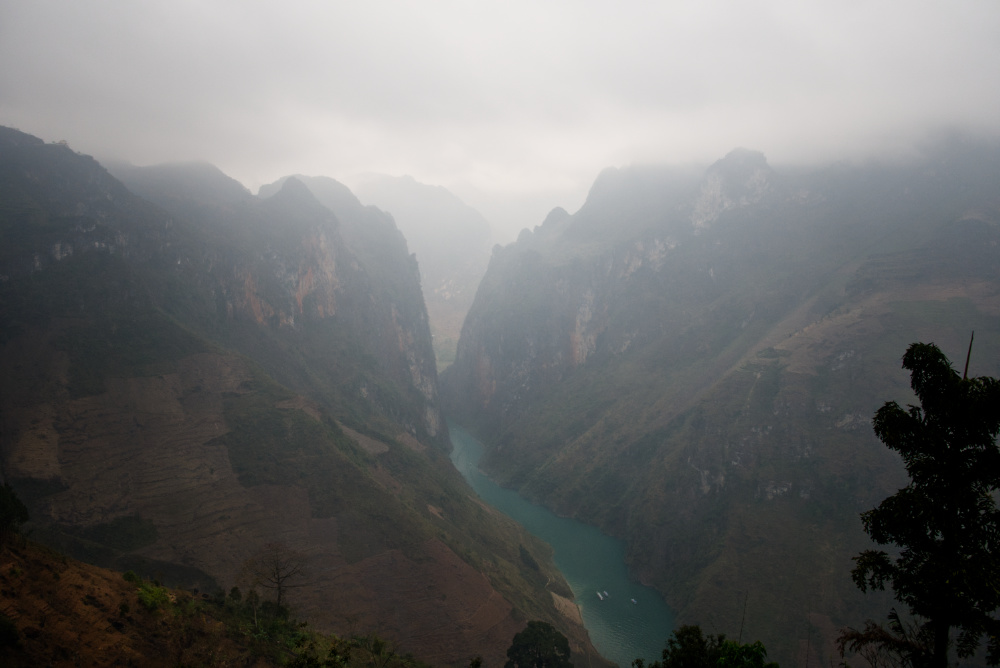Some of the links in this post are affiliate links. This means if you click on the link and purchase the item, I may receive an affiliate commission at no extra cost to you.
Vietnam is a country with a rich and diverse wildlife, so taking a wildlife tour is a great way to experience some of that wildlife. I’m here to help you narrow down the options to find the best Vietnam wildlife tour for your trip. Most of the wildlife tours below are day trips so would be great to squeeze in if you have a spare day or two in Hanoi or Ho Chi Minh.
Among the top destinations for wildlife viewing in Vietnam is Cuc Phuong National Park, the Can Gio area, and Vam Sat. In these places you’ll spot a range of primates such as macaques and gibbons, buffalo, birds and reptiles.
Cuc Phuong is home to a variety of endangered species, including the critically endangered delacour langur, which the team at the Endangered Primates centre are helping to preserve. The langurs are among the rarest primates in the the world, with only a few hundred left in the wild.
A wildlife tour in Vietnam is a great way to get up close and personal with the country’s diverse wildlife. In addition to the above, there are a number of other destinations that are popular among wildlife enthusiasts, such as the Son Tra Peninsula (monkey mountain), which is home to the red shanked douc langur, another endangered primate species.
Other highlights of a wildlife tour in Vietnam can include watching playful monkeys swing and jump through trees, spotting water buffalo grazing amongst picturesque fields, and observing colourful bird species such as the green peafowl and the oriental pied hornbill.
With so many amazing wildlife destinations to choose from, a wildlife tour in Vietnam is a good change of pace from exploring temples and cities, and will be sure to leave a lasting impression.
The Best Vietnam Wildlife Tour (if you’re in a hurry)
My pick for the best Vietnam wildlife tour is taking a private tour of Cuc Phuong National Park. Its an easy day trip from Hanoi to Ninh Binh and the park isn’t as busy as other places in the town, despite being a great place to spot wildlife.
I love that you get to see the endangered monkey centre and then also get to do some trekking in the afternoon to spot wildlife.
Quick Must Haves
I recommend the following three items as must haves for your Vietnam holiday: a good quality (but affordable) memory card, an international plug adapter, and noise canceling earphones. The headphones make long journeys easier, the memory card to take lots of photos, and the international plug adapter to make sure you can charge your belongings in Vietnam.
What Wildlife Can You See in Vietnam?
Vietnam is a place that boasts a wide variety of wildlife, with the focus for tourists mostly being around birds or monkeys. The former often being seasonal, and the latter normally seen a little off into the distance. Buffalo are also quite popular in rural areas, alongside your regulars such as chickens and ducks who roam around.
One of the most famous bird species found in Vietnam is the Vietnamese pheasant. The pheasant has vibrant plumage, with iridescent green, blue and black feathers. Another type of bird that is commonly seen in Vietnam is the black crowned night heron, which has a distinctive black head and white face.
Other bird species that can be found in Vietnam include the green peafowl, the Oriental pied hornbill, and the great hornbill. These birds are able to be spotted in Vietnam’s national parks and other protected areas in the country.
In addition to the country’s birdlife, Vietnam is also home to a number of monkey species. The most famous of these is the golden headed langur, also known as Cat Ba langurs, which is found of the coast of Northern Vietnam on Cat Ba Island. The golden headed langur is an endangered primate which has a bright orange-gold coat, and a distinctive, almost human like face.
Another monkey species that can be found in Vietnam is the long tailed macaque, which is a more common sight in urban and rural areas. These playful monkeys are known for their curiosity and can often be seen in groups scavenging for food to eat, and causing mischief.
Best Vietnam Wildlife Tours to See Monkeys, Birds + More
Wildlife tourism has not fully taken hold of Vietnam, so some of the tours below will combine wildlife sighting with exploring temples or other monuments. However there are a few tours that focus primarily on national parks and wildlife sightings.
Private Can Gio Mangrove Forest Tour
This is a great option if you’re traveling in a group or even solo, and want a private guide. The tour takes you to Can Gio Mangrove forest where you’ll be able to explore the forest and take a canoe ride to see crabs, deer and bats.
Afterwards you’ll have a trip to Monkey Island which is home to over a thousand monkeys. Don’t worry – they’re spread out.
This tour is good if you want to see a wide variety of animals in a day. It begins and ends in Ho Chi Minh City.
Private Cuc Phuong National Park Trip
This tour is a great option if you want to have a mix at visiting a conservation centre and also having some time to hike around, in one day.
In the first half of the tour you’ll visit the Endangered Primate Rescue Center where you can see and learn about langurs and monkeys. The center’s aim is to help stop these beautiful animals from becoming extinct.
The tour begins and ends in Hanoi, but Ninh binh is only 2-2.5 hours away. This one is my top pick as I thought the Tam Coc / Ninh Binh was so beautiful, and the focus of the tour is wildlife.
Private Vam Sat Mangrove Tour
Can you guess I love a private tour?
This tour originates in Ho Chi Minh and takes you on a day trip to the Vam Sat mangrove forest and Can Gio.
Vam Sat was previously the victim of bombing in WW2 but now is a testament to the beauty of South Vietnam. Here you can see a variety of wildlife such as monkeys, gibbons, crabs and a number of bird species. Here you have the option of visiting a crocodile reserve or taking a hike in the park to spot birds.
You also get to hop on a boat and explore the mangroves in Can Gio which has more than 50 flora and 200 fauna species in its boundaries.
2 Day Ninh Binh and Cuc Phuong Tour
This 2 day tour is a good option if you have a bit more time to spare. It combines a day in Cuc Phuong with a bike tour of local villages and a boat ride through Tam Coc.
On the first day you’ll drive to Tam Coc from Hanoi and hop on a boat ride through Tam Coc. Out of all the boat rides in the Tam Coc / Ninh Binh area, I found Tam Coc to be the most visually impressive with beautiful rice fields and caves. After this you’ll hop on a bicycle and explore a nearby village.
The second day is spent exploring Cuc Phuong National park. You’ll visit the Endangered Primate Rescue Center and also have some time to explore the park via a guided walk. There’s a good chance to spot birds and monkeys here.
Hoi An Countryside by Electric Scooter
If you don’t specifically want to see monkeys or birds, but just want to see animals in general, this tour is a fine option. You’ll get to drive through a local village and also the countryside.
You’ll see waterbuffalo, and may also spot ducks, chickens and other more domestic animals on your ride.
Bach Ma National Park
Technically this tour is focused on visiting the lakes in the park, but there’s a good chance to spot wildlife as you go. Sightings aren’t guaranteed, but if you see some wildlife it makes them even more special because you can’t control when wildlife will show up.
There’s trekking, which requires a moderate level of fitness, a walk to the Do Quyen waterfall, mountain views, and you can also do some swimming in the Ngu Ho lake. You’ll be able to hear different birds here, so keep an eye out for them.
This tour can start from Hue, Da Nang or Hoi An, and may not be suitable for unfit travelers due to all the hiking.
What to Expect on a Wildlife Tour in Vietnam?

Typical Itineraries
A typical itinerary for a Vietnam wildlife tour would include 2-3 locations to see either purely wildlife, or wildlife and local structures or culture.
Lodgings on Vietnam Wildlife Tours
The type of lodgings you can expect on a Vietnamese wildlife tour is basic to midrange accommodation. Tours aimed at backpackers will often feature a dorm, while midrange and private tours will offer a basic private room or homestay.
Don’t expect anything super fancy here unless the tour page specifically mentions it.
Transport
Transport on wildlife tours is done by private vehicles owned or utilised by the tour company. You will often be transported in minivans rather than joining public transport unless stated in the itinerary.
However if going on a boat at a national park, this will be the property of said park. Still, you will often have the boat to yourself or will share with other members of your tour group. Boats such as the ones at Tam Coc are small, suiting 2-6 passengers.
Tour Guides on Wildlife Tours in Vietnam
Tour guides are mostly locals who have been hired by the company, and (hopefully) have a passion for the sights they’re showing you. I personally found the tour guides I had in Vietnam to be of a good standard, some had tons of energy, while others were just plain friendly.
Safety in Vietnam
Safety standards in Vietnam may not be as high as they are in the West, so be aware of that, but the country is still generally safe. Driving can be interesting, and is not recommended to do so yourself unless you have experience driving in Asian countries.
Your driver may make some moves you find questionable, but these are often necessary in Vietnam, due to how everyone drives. Focus on what is in your control such as wearing a seatbelt, and being aware of your surroundings when walking or cycling down roads.
Best Time to Visit Vietnam for Wildlife Sightings

Vietnam is a good place to visit, especially for birds, monkeys and animals such as buffalo, chickens and ducks. Most people are understandably more interested in the monkeys and birds, being more unique to Vietnam, hence we’ll focus on them below.
The best time to visit Vietnam for wildlife sightings depends on several factors, including the species you want to see, their migration patterns, and the weather conditions in the different regions of the country.
Weather and Season
Best time to see birds in Vietnam – Vietnam is a fantastic place to go bird watching, with more than 900 bird species recorded around the country. However the best time to see birds in Vietnam depends on the region and species you want to observe.
Generally, the best season for bird watching in Vietnam is from November to April, which is the dry season and offers favourable weather conditions for bird sightings. During this time, many migratory bird species from Siberia, China and Japan make their way to Vietnam. This makes it an ideal time for birdwatchers to spot rare and regular species.
However, in the central highlands, the birding season runs from February to April, while in the Mekong Delta, it is best to go birding between December and April.
Additionally, some species are easier to spot during the wet season, such as the pheasant tailed jacana, so its worth researching the specific species you wish to observe and plan accordingly.
Best time to see monkeys in Vietnam – The best time to see monkeys in Vietnam varies depending on the species and region, like above.
The black shanked douc is best seen from December to March when they congregate in large groups in the forest canopies of Son Tra Nature Reserve in Da Nang, or the Bach Ma National Park in Hue.
The critically endangered delacour’s langur is most easily spotted in the Van Long Nature Reserve near Ninh Binh from December to April when the water level is low, and the limestone cliffs are exposed.
I would recommend bringing binoculars are the ones I saw were quite far away, and it would have been better to see them closer up. My boat rower seemed quite excited to see them so I’m not certain how common spotting them is.
The golden headed langur is found in Cat Ba National Park, and the best time to see them is March to May when they venture out of the forest in search of food.
Breeding & Migration
As above, the best time for most birds is generally November to April, due to many migrating from neighbouring and nearby countries at this time.
Tips for Wildlife Photography in Vietnam
Wildlife photography can be a rewarding, yet challenging experience. Here are some tips for catching stunning images of monkeys and birds in Vietnam.
For birds:
- Bring a long lens: A zoom lens longer than 300mm is ideal for bird photography as it allows you to capture fine details and frame your subject tightly. However, I would only recommend lugging this around on vacation if you are really into birding, due to how heavy these lenses are. A 200-300mm lens if a better choice for those not as focused on getting the perfect shot – you can always crop.
- Use a fast shutter: Birds are fast moving creatures so using a fast shutter speed is essential to capture sharp and in focus images.
- Find good light: Good light is critical for capturing vibrant colours and sharp details in your images. The early morning or late afternoon provide the best light.
- Be patience and observant: while not possible in a quick day tour, if you have some time on your own to explore you can really make a day of it if you find a good spot.
For monkeys:
- Respect their space: Monkeys are wild animals, and its important to keep a safe distance from them. Don’t disturb their natural behaviour.
- Use a fast shutter speed: Like birds, monkeys are quick and agile. Using a fast shutter speed is crucial to capturing sharp and in focus images.
- Look for unique moments: try to capture unique moments that showcase the monkey’s behaviour or personality. This could include them grooming or playing with the other monkeys.
- Be aware of the environment: Monkeys often inhabit dark forests or other challenging environments so you may encounter low light conditions or other obstacles.
Responsible Wildlife Tourism in Vietnam

The Importance of Ethical Wildlife Tours in Vietnam
Its important to seek out tours and experiences which promote sustainable wildlife interactions. This may include avoiding tours where you are able to hold animals, especially is those animals are drugged or restrained.
Instead, its important to seek out reputable sanctuaries and research organisations, or do tours that involve seeing wildlife in their nature habitat from a distance. Raise your concerns with operators if you see guides or other tourists doing things that endangers wildlife.
Threats to Wildlife in Vietnam
Vietnam’s wildlife faces threats such as habitat loss, poaching and the illegal wildlife trade. The country’s rapid economic development has led to deforestation and destruction of natural habitats, as is a common problem in all countries. Unfortunately this progress can push many species to the brink of extinction.
Cultural and traditional medicine practices can also contribute to the demand for wildlife products sourced from illegal wildlife trade. This puts further pressure on already vulnerable species.
Ways to Help Preserve Wildlife in Vietnam
It’s important to note that many monkey species in Vietnam are endangered, and their habitats are under threat. So it is essential to observe them from a respectful distance, and follow the guidelines set by the local authorities and conservation groups to ensure their continued survival.
Vietnam Wildlife Tours FAQ
Are Vietnam wildlife tours suitable for children? Yes, most tours are suitable for children, although be mindful of how much walking may be involved. Although keep in mind that sightings out in nature may require quietness, so a wildlife tour would not be the best place for a crying baby.
What camera and lens should I take to Vietnam for wildlife photography? If budget permits, the best option would be an SLR or mirrorless camera with a zoom lens. The longer zoom the better, but anything that will let you get closer is good. You can find some affordable lenses that go up to 200 or 300mm that wont weigh you down too much.
Do I need binoculars on a wildlife tour? I would recommend taking binoculars for spotting monkeys and birds. You can find some affordable ones under $100 in stores or online.